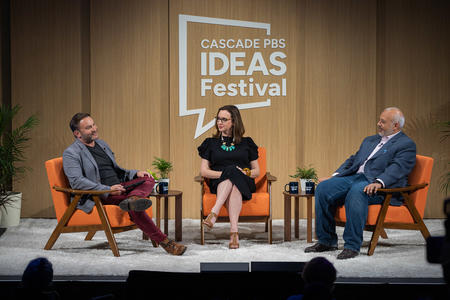Thai restaurants have become so common in Seattle over the past 20 years, the appearance of one signifies little these days. They show up near colleges, in mall food courts, in the suburbs, and in duplicate and triplicate on the gentrified blocks of Wallingford and Fremont.
Cities and even small towns all over the country now have Thai restaurants. Familiar enough to be comforting, exotic enough to be exciting, Thai food has caught on the way Chinese food and Indian food caught on decades earlier. Certain Thai dishes like phad thai and coconut curry are so popular, they are often thrown onto menus at Japanese and Chinese restaurants to ratchet up business. It did not take very long, 15 to 20 years at most, for Thai food to hit the mainstream.
As a result, it has become difficult for a Thai restaurant in Seattle to distinguish itself. An inconspicuous Thai restaurant owned by wife and husband Noi Seneboutarath and Tom Tu has managed to part from the crowd in a few ways. For one, their restaurant, Thai Palms, is located on Martin Luther King Jr. Way South in a stand-alone building near the Othello Street light-rail station, not too far but a world apart from the Columbia City strip of gourmet ice cream and Neopolitan pizza.
Instead of helping business, the light rail seemed to stifle it, they said, thwarting or discouraging the car traffic that might help fill the restaurant, which has a narrow parking lot in front. The neighborhood has a concentration of Vietnamese restaurants and businesses, most of them clustered in strip malls along the arterial. Mexicans, Chinese, Africans, Filipinos, Samoans also keep their businesses and institutions in the blocks around Thai Palms, but Vietnamese food is the most common in this area. Here, Thai food is actually unusual.
Secondly, Thai Palms also serves Lao food. Seneboutarath is from Laos but grew up in neighboring Thailand because her father served in the Thai military. Theirs is one of very few restaurants — Viengthong in Mount Baker is another — that openly serves Lao food. Seneboutarath said that some Thai places will cook Lao food for you if you know what to ask for, but it will likely be prepared using a Thai interpretation.
“Here, we make real Lao food,” said Tu, who is from Vietnam.
In a way, all Thai restaurants serve Lao food, or their version of it. Green papaya salad and larb, the tangy, chicken salad, actually have their origins in Laos. Most Thai restaurants will use ground or minced chicken that is poached or braised; Tu makes his larb ($8.99) by grilling the chicken first, then coarsely chopping it. The papaya salad at Thai Palms is also served Lao style with dried shrimp and chunks of salted, raw, blue crab ($8.99).
Thai and Lao food are similar. In northern Thailand, near the Laos border, the differences are even harder to discern. Lao cooking is less sweet and more pungent because of the liberal use of fermented fish. By comparison, Thai fish sauce is relatively mild. Lao cooks do not use coconut milk, common in Thai cooking. And instead of jasmine rice, the Lao eat sticky rice.
The trick to eating Lao food at Thai Palms is to ask for the Lao-only menu, usually kept hidden in a cabinet near the front door. Lao items are on the main menu but are difficult to distinguish from the Thai items unless you know what you are looking for, like the Chinese broccoli sautéed with fermented fish ($8.99), or nam khao tod, sour, ground pork with peanuts and crispy rice ($7.99).
Although there is a significant Lao community in the Seattle area — there are soccer teams and Buddhist temples, and a few blocks away from the restaurant near Graham Street is a Lao grocery, called Vientiane — there are very few Lao restaurants, a mystery that even Tu and Seneboutarath do not completely understand.
Restaurants in the Seattle area that serve Mexican food, Vietnamese food, and Thai food thrive because there is a large number of immigrants from those countries to patronize the restaurants and because there is mainstream demand for the food. Without one or the other, it is difficult to support a daily operation. That is why you do not see many if any Russian, Cuban, or Columbian restaurants, and why so few Lao restaurants are open for business.
That also is why Thai Palms and Viengthong, too, serve Thai food. “For newcomers, it is hard to eat Lao food,” Tu said.
The Thai dishes, which are more popular and familiar, end up subsidizing the Lao dishes. When customers ask, the staff is happy to describe and guide them through the subtleties of Lao cooking.
“If you love Thai food, I think you will really like Lao food too,” Tu said.
Tu is ethnic Cham, considered the indigenous people of southeast Asia. The Cham people are a minority in Vietnam, Cambodia, and Thailand; thousands were victims of the Khmer Rouge genocide in Cambodia. They have their own language and are said to have migrated from Borneo thousands of years ago. Most of the Vietnamese Cham, like Tu, live in central Vietnam around Ho Chi Minh City. Many Cham are also Muslim, the likely result of early contact with Arab traders.
Tu is Muslim although he does not practice it strictly. While Tu cooks pork, he does not eat it.
“Some people tell me it’s bad luck,” he said, “but as long as I don’t eat it, it’s OK.”
Tu met his wife in Seattle, where her family came to live after being sponsored by a Mormon temple. The family, in part, converted. And that is how a Mormon-Lao-Thai woman and a Muslim-Vietnamese man came to open a Thai-Lao restaurant in a Vietnamese-American neighborhood in Seattle.
If you go: Thai Palms, 6715 Martin Luther King Jr. Way S., 206-721-7777. Open Monday, Wednesday-Saturday 11 a.m.-9 p.m.; Sunday, 11 a.m.-8 p.m.



